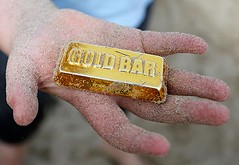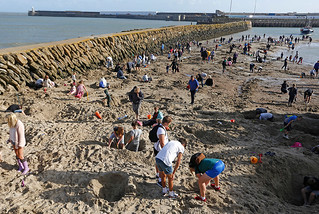
PREV ARTICLE
NEXT ARTICLE
FULL ISSUE
PREV FULL ISSUE
ARTISTS LURES GOLDDIGGERS TO BRITISH BEACH
Via the Art Daily newsletter I learned of a fun event at the Folkestone Triennial art festival; an artist buried gold bars on a British beach and invited people to search for them.
-Editor
The gold bars, worth a total of £10,000 (13,000 euros, $17,000), were buried in Folkestone, southern England, by Berlin-based Michael Sailstorfer as part of an arts festival. Members of the public will be allowed to keep any of the 24-carat bullion which they find. "There are 30 gold bars buried there, along with a lot of washers, so if you bring your metal detector you will find a lot of washers before you find any gold," festival curator Lewis Biggs told the BBC. "We will never know if the gold has been found or not." To read the complete article, see: Gold rush as artist buries bullion on British beach as part of Folkestone Triennial (artdaily.com/news/72477/Gold-rush-as-artist-buries-bullion-on-British-beach-as-part-of-Folkestone-Triennial#.VAG7sPmzFYE)
Here's more from The Guardian.
-Editor
It is an artwork that has been shrouded in secrecy for obvious reasons: there are 30 gold bars worth a total of £10,000 buried on the beach in Folkestone and once the tide is out at 4pm on Thursday it's finders keepers. Organisers of the Folkestone Triennial on Thursday afternoon revealed details of a project it has been desperately trying to keep under wraps. The German artist Michael Sailstorfer has buried gold bullion in the sand of the Outer Harbour beach and once the sea is out, people will be able to come and dig for it. "I think we might well have a lot of people," said the Triennial curator, Lewis Biggs, with understatement. "It is a participatory artwork. It is about people coming to the beach and digging and possibly finding hidden treasure. Some people will get lucky, some people will not get lucky – and that's life." The bars are of different sizes and standard gold bullion marked Made in London, although anyone expecting the kind of gold bars you see in heist films may be disappointed. Nevertheless, each bar could be worth several hundred pounds and if you find one – it's yours. Biggs said the work raised intriguing questions about what people would do with any gold they found. "An interesting part of the artwork is considering whether it is going to be worth more as an artwork. Do you take it to the pawnbrokers or do you take it to Sotheby's? Or do you keep it on the mantlepiece because you think it is going to be worth more later? Will its price increase as an artwork or as a piece of gold?" The piece, called Folkestone Digs, has been commissioned by the Bristol-based arts producers Situations, an organisation trying to change the perception of what public art can be, its director, Claire Doherty, said. The Berlin-based Sailstorfer has chosen not to be in Folkestone for what could become remembered as the great bucket and spade gold rush of 2014. He wants to let "the work unfold," said Doherty. "As simple as that." Sailstorfer is interested in changing the way people view a place and his previous work includes collecting fallen autumn leaves, painting them green and reattaching them to a tree so it looks like spring. Another involved him feeding the rotting wooden walls of a chalet to a wood burner over the course of a day until nothing remained in the landscape except the wood burner. Doherty said the Folkestone project fitted in with Sailstorfer's aim of making art "that comes less from the head and more from the stomach". She said the Folkestone work evoked thrilling gold rush stories. "Plus it is childlike, children search for treasure and the seaside is absolutely about that. The digging today will be no different to what has been happening all summer." There are safety plans in place should it get extremely busy and a number of metal washers have also been buried to fox those who decide to get the metal detector out of the loft. To read the complete article, see: The golden sands of Folkestone: artist buries £10,000 of bullion on beach (www.theguardian.com/artanddesign/2014/aug/28/gold-sand-folkestone-beach-artist-michael-sailstorfer)
 So what do these bars actually LOOK like? Here's a picture of a fake one made of plastic, apparently buried at the beach as well. Neither of the publications had images of the real bars, although the Guardian had a description. It'll be interesting if one of these "Made in London" bars turns up in the numismatic market. Could be a rarity someday, and who knows - maybe one will turn up on that beach 100 years from now.
So what do these bars actually LOOK like? Here's a picture of a fake one made of plastic, apparently buried at the beach as well. Neither of the publications had images of the real bars, although the Guardian had a description. It'll be interesting if one of these "Made in London" bars turns up in the numismatic market. Could be a rarity someday, and who knows - maybe one will turn up on that beach 100 years from now.
Or are there really any gold bars at all? Could it be a hoax? All part of the fun, I guess. We'll only know if someone reports their find to the media and a follow-up story is written. Let us know if you come across any reports. -Editor Wayne Homren, Editor The Numismatic Bibliomania Society is a non-profit organization promoting numismatic literature. See our web site at coinbooks.org. To submit items for publication in The E-Sylum, write to the Editor at this address: whomren@gmail.com To subscribe go to: https://my.binhost.com/lists/listinfo/esylum All Rights Reserved. NBS Home Page Contact the NBS webmaster 
|
